that festival feeling
gail priest: interview jo duffy, ten days on the island
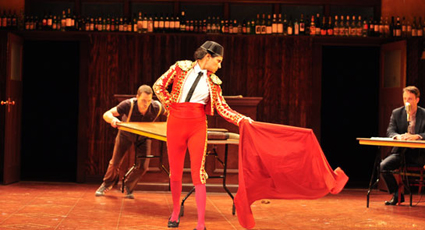
The Select, Elevator Repair Service
photo Rob Strong
The Select, Elevator Repair Service
BACK IN 2001, TASMANIA WAS A QUIET STATE. IT HAD FINE FOOD AND WINE, BREATHTAKING NATURAL WONDERS AND SOME KEY CULTURAL INSTITUTIONS, BUT IT WASN’T REALLY KNOWN FOR FESTIVITIES (GIVE OR TAKE A FEW POPPING CORKS AT THE END OF THE SYDNEY TO HOBART).
So the Premier Jim Bacon decided they needed a festival. He put the irrepressible Robyn Archer in charge (now heading up the Canberra Centenary see realtime tv interview) and Ten Days on the Island was born, a biennial festival servicing the state with exciting cultural wonders from islands large and small around the world, as well as profiling local talent.
the duffy touch
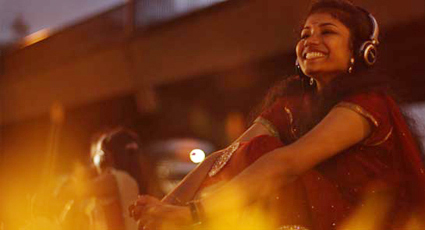
The Other Journey, CuriousWorks
courtesy Ten Days on the Island
The Other Journey, CuriousWorks
The festival is now in its seventh incarnation, passing through the founding stage with Archer, through to consolidation with Elizabeth Walsh, and now in the firm but gentle hands of Jo Duffy, previously director or the Darwin Festival. While Duffy, a long-time fan of the festival, had no desire to make sweeping changes, she has made a few shifts to the structure that she hopes will enhance the festival experience.
By 2011, the festival was taking place in around 64 locations throughout the state. Duffy has decided to concentrate the activities to 10 key locations. Rather than a one off fling, each town gets a comprehensive festival experience with a selection of shows over consecutive days, a supper club for before- and after-show communing and a series of public programs including workshops and artists talks.
Duffy says: “What I felt I could bring to Ten Days on the Island was to further develop the festival atmosphere so it has the potential to take over [each] town; to build up the momentum and the enthusiasm of people to go and see things they wouldn’t normally go and see. To encourage people to go to a bar after a show and talk about what they’ve seen and have the opportunity to meet some of the artists.”
The challenge with this format is choosing shows that will work across multiple locations. Duffy says: “The curatorial process started with getting to know people all around Tasmania—getting a general sense of who they are, whether they already engage in the arts, and if they don’t, why they don’t. The Tasmanian population is quite evenly spread right across state… [The towns are] so close together here, six or seven minutes apart, so they have a mixture of people. You have a number of seniors, some early retirees, you’ll get a group of professionals, young families, people who work in the timber industry, people who work in the Antarctica division, scientists… everybody is kind of all in together. So that gives a certain amount of freedom. There’s probably nothing in the program, with the exception of logistics of size, that I wouldn’t put in one town because of its content.”
That said, there are a few shows that are being tailored to their locations. CuriousWorks’ The Other Journey was previously devised in Parramatta reflecting the stories of a range of migrants from Sri Lanka (see RT106). The company is adapting the work to include stories that reflect the experiences of Sri Lankan people in the Glenorchy region.
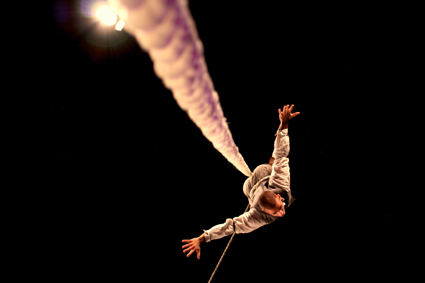
Ockham’s Razor
photo Nik Mackey
Ockham’s Razor
Also UK aerial company Ockham’s Razor will perform a full show at the Theatre Royal in Hobart, but then adapt a section of their work to be performed in the rafters of the old train station in Queenstown. Duffy explains: “One of the reasons we’re taking Ockham’s Razor to Queenstown is that about 100 kids in the area have been involved in circus workshops over the last 18 months with Slipstream, a Tasmanian circus company. They have an interest in that kind of work already so for us to be able to take the company over there shows the kids not only the best in the world, but also that these people are making a career out doing what they’ve been learning in the workshops.”
exchange and legacy
This potential for connection and exchange is a vital part of Duffy’s vision and has been formalised into a huge program called Beyond Ten Days. It offers a plethora of activities from artist talks, master classes and workshops to professional secondments for young people interested in developing a career in the arts. Duffy says “There’s quite a lot of industry interaction, and that goes both ways. In some cases the visiting artists are learning something from Tasmanian artists and in other cases it’s the other way round… [We’re] even helping people who work in the arts to get to know the facilities that are available here now for audiences and other artists with special needs—things like captioning services, live interpretations of shows, touch tours before performances.”
This idea of the festival creating lasting legacies within the Tasmanian culture has always been a key item on the festival agenda. Over the last 12 years the festival has gone into small towns working with local groups and councils to enhance not just cultural understanding but also the physical infrastructure, installing three-phase power in local town halls and creating accessible, professional venues that are now part of a much wider touring circuit. Duffy says, “There are other arts companies in Tasmania like Tasperforms, the Tasmanian Symphony Orchestra, Tasdance and the Tasmanian Theatre Company who now tour a lot more to really small locations because those venues are established and they’re able to use them.”
the program
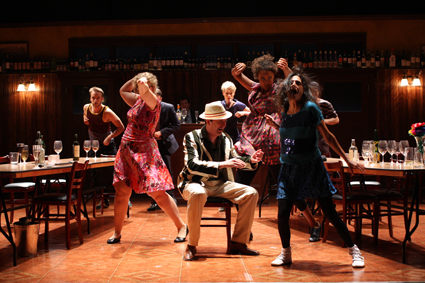
The Select, Elevator Repair Service
photo Rob Strong
The Select, Elevator Repair Service
Scanning Duffy’s first program it looks like a well-balanced, healthy yet tasty banquet with a little something for everyone, which Duffy sees as vital for festivals that can’t rely purely on a capital city audience.
The international centrepiece is by US company Elevator Repair Service, who appeared in Sydney in 2009 with their courageous seven-hour reading of the Great Gatsby (RT91). Here they take on Hemingway’s The Sun Also Rises, which roams from the US to the ennui-tinged cafes of Paris to the passion-soaked streets of Spain in the 1920s. While still epic it’s an excerpted adaptation thus its title, The Select.
Equally grand in vision is the collaboration between Terrapin Puppet Theatre and the Tasmanian Symphony Orchestra, Shadow Dreams, which sees the performance taking place simultaneously in two locations (Hobart and Launceston, then Hobart and Burnie), linked by the early manifestations of the National Broadband Network. Written by Finnegan Kruckemeyer, it tells the story of two young boys who awake one morning having dreamt each other’s dream.
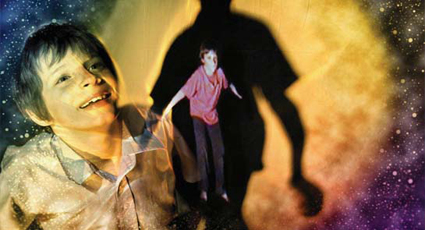
Shadow Dreams, Terrapin Puppet Theatre and the Tasmanian Symphony Orchestra
courtesy Ten Days on the Island
Shadow Dreams, Terrapin Puppet Theatre and the Tasmanian Symphony Orchestra
Local talent is also being nurtured in dance with Finding Centre, the choreographic debut of Trisha Dunn a former Tasdance company member. She will be exploring the physical and psychological idea of finding balance in contemporary life, in collaboration with visual and video artists Jason Lam and Adam Synnott. Tasperforms will present locals—playwright Tom Holloway and actor Robert Jarman who have teamed up to create As We Forgive: Three Morality Tales for an Amoral Age, a solo performance, accompanied by cello exploring solitude, grace and revenge. Tasdance will also be touring Luminous Flux, a double-bill featuring a work choreographed by Tanja Liedkte in 2004 and Melbourne’s Byron Perry. And there’s also a show by local art academic turned comedienne, Hanna Gadsby.
There are performances by Dublin’s HotForTheatre, Brisbane’s Circa, two shows by Sydney’s Erth Physical and Visual Theatre, music form Corsica and Cape Breton (Canada), a screen-dance installation by Sue Healey as well as a comprehensive visual arts and literature program.
the state of festivals
Since the first Ten Days on the Island, the Tasmanian cultural landscape has changed dramatically. Riding the wake of Ten Days, there are now multiple major festivities across the year. Most recently on the scene is MONA FOMA which will also be instituting a winter festival in 2013 titled Dark MOFO (RT89, RT96 and RT108). Also making waves are the live art activities of Junction Arts in Launceston (see RT110, and RT99).
So is there room in this small state for all this art? Jo Duffy believes there is: “Everybody works closely down here, there’s a very strong collegiality within the arts industry. And the main proof is in the pudding—people are attending all of the events and the levels are fantastic. So the audiences are coming. There’s certainly room for everyone.”
Ten Days on the Island, Hobart, Launceston, Burnie, Huonville, Campbell Town, Swansea, Deloraine, St Helens, Queenstown, Devonport & Latrobe, plus single events at Flinders Island, King Island and Port Arthur, March 15-24; http://www.tendaysontheisland.com
RealTime issue #113 Feb-March 2013 pg. web






